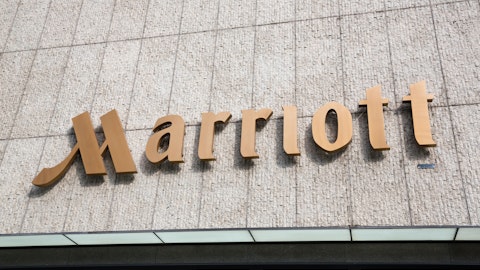Salvator Tiano : Yes. So firstly, I wanted a little bit to understand the dynamics for HIP in Q2. I mean when you look at the past couple of years, it looks like mainly because of seasonality, you get probably a $30 million or $40 million EBITDA boost in Q2 versus Q1. As we think about this right now and with your strong order backlogs, is this the same — should we have the same expectation? Or are there — or perhaps there was any pull forward in business in Q1?
Steve Bender: No. I think we’ve seen kind of a continued strength that we saw at the tail end of the year. So obviously, there’s a seasonality to the business that we normally see. I think the first quarter is not a pull forward, but a continuance of the demand picture of the underinvestment both in infrastructure and in housing. So as I mentioned, the strength that we’re seeing with our nationwide homebuilder partners, they’re continuing to grow market share, and that isn’t necessarily a front load and that’s just simply being able to grow with the market as those nationwide homebuilders continue to grow their market share. We’re participating in that. And that’s not really a pull forward per se.
Salvator Tiano: And I guess that brings on my second question, which is if we continue to see the positive trends here in Q2 and given what you’ve recorded and that you kept the guidance on change for the segment, it looks to us that you should be — you essentially expect to do well below $200 million EBITDA in each of the last 2 quarters of the year. So that will be a meaningful step down, obviously, mostly on margins. So what in your expectation would drive that would be a very big volume decline or price cost would narrow significantly?
Steve Bender: Yes. As I mentioned, as we look into the second half of the year, it’s harder for us to see the entire third and fourth quarter. And as we see that, if we do continue to see the strength we’ve seen so far, we’ll assess our guidance going forward. But at this stage, we haven’t adjusted our guidance. But as I say, if we continue to see strength in this business, we’ll assess the second half of the year as we approach that. But I would say we continue to see good strength into the second quarter as we go through here. The headwind really would be only in being able to push through some of these PVC resin prices and our downstream building products businesses. But given the strength in the backlog we see, we think we’ll have good success on that front.
Operator: The next question is from Matthew Blair at TPH. Your line is open.
Matthew Blair: I wanted to ask about Slide 5, especially the comment regarding the strong demand you’re seeing for large diameter pipe. Are there any numbers you can share around that? And I guess, is the implication there that some of the homebuilders are they’re starting like brand-new developments, putting in the initial infrastructure but really haven’t started on the actual housing construction yet?
Steve Bender: Well, of course, the infrastructure leads. And so as we think about the strength that we’ve seen in our infrastructure business, this is the pipe and fittings business, that continues to be, as I say, good strong backlog, and we continue to see that leading the construction going into our exteriors business. This is the Westlake Royal business. And so certainly, given the nice position that we have nationwide with our Pipe & Fittings business, we think it does perform — will continue to perform well. It has in the first quarter, and we expect that to continue into the second quarter with backlog. So while we don’t provide specific volumes for each one of these subsegments of the HIP business, I would say we’re continuing to see very good strength within this segment of the business.
Matthew Blair: Sounds good. And then you mentioned that the in HIP areas like Pipe & Fittings as well as Siding were especially strong. What areas are you still looking to catch up on? What areas are a little bit softer right now.
Steve Bender: So certainly, as we think about the businesses that have stronger margins, those that we just called out. And I’d say some of the businesses where there’s a larger number of players. I’d certainly say the Windows business certainly is a bit more challenged than I would say the Siding & Trim business which we called out as having very good strength in Pipe & Fittings having very good strength.
Operator: The next question is from Arun Viswanathan of RBC Capital Markets. Your line is now open.
Arun Viswanathan: I guess I just wanted to understand the sequential ramp here that we should maybe be thinking about Q1 to Q2. So it looks like HIP was up about $100 million from Q4 to Q1. And PEM was up about $50 million. When you think about Q2, I think where — I’m on the impression that maybe HIP is us up about 15% sequentially, maybe PEM a similar amount, maybe HIP could be a little bit more. How are you thinking about that? It seemed like volume really drove the quarter, and you still have a similar kind of volume uplift as you look into Q2?
Steve Bender: Yes. So Arun, as we think about the Building Products business, I would say volume continues to be good. As I mentioned several times, we’ve got — we’ve a good backlog. We will be looking to try to push through these PVC price increases that we achieved in the first quarter through that chain. And so that remains really the headwind in terms of being able to expand margin as we go forward with this higher volume.
Arun Viswanathan: And what about PEM, sorry, as you go into Q2?
Steve Bender: Yes. Certainly, you’ve seen the tailwind we’ve seen and pricing traction both in PVC and polyethylene as well as in caustic. And certainly, the strength that we’ve seen with those price improvements over the course of the first quarter, we hope to continue. Prices seem to have stabilized at these elevated levels. And as we look forward, there’s really — as we see a good reason to think that those prices will remain at these elevated levels now that we’ve achieved that improvement in pricing across those products.
Arun Viswanathan: And just as a follow-up then. So what is kind of the backlog typical for HIP? Is it in weeks or months? Or how much visibility do you have? And then along those lines, if you do have a fair amount of visibility, would that — would you consider that we should kind of be looking at, say, 20% to 25% as far as EBITDA margin for HIP on a more consistent basis. I think you’ve been above your 15% to 20% range for several quarters now.
Steve Bender: So Arun, we can typically look at a couple of months in terms of order in the order books. Of course, at any point in time, they can cancel orders, of course. But the guidance that we provided of approximately 20% is really kind of where we are at this stage, and we’ll update that guidance as we progress through the course of the year.




